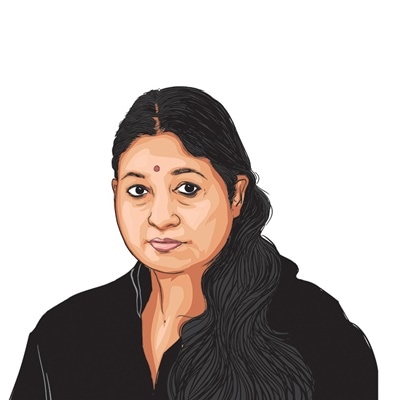Opinion Pluralism is the essence of Hinduism. Is it now becoming more performative?
For Hindus, there has never been a single way to practice faith.
 An aerial view of devotees taking a holy dip at the Sangam area during the ongoing Maha Kumbh Mela festival, in Prayagraj, Uttar Pradesh. (PTI Photo)
An aerial view of devotees taking a holy dip at the Sangam area during the ongoing Maha Kumbh Mela festival, in Prayagraj, Uttar Pradesh. (PTI Photo) What is happening to my religion during the ongoing Maha Kumbh is forcing me to contemplate if Hinduism is moving toward a more codified, performative and mandatory form. Deaths in stampedes, visuals of people damaging rail windows and the choking of cities by crowds eager to take a holy dip are indicative of a turn in Hinduism. Hinduism, traditionally a diverse and pluralistic system of beliefs, has undergone significant transformations in recent times. It is increasingly adopting characteristics often associated with Abrahamic religions — such as centralisation, doctrinal rigidity, mass mobilisation, and an emphasis on obligatory practices. This shift is particularly visible in large-scale religious gatherings like the Kumbh Mela, where we witness both heightened devotion and, unfortunately, instances of irrational violence, chaos, and stampedes — a departure from the organic, regionally diverse expressions of Hinduism.
Traditionally, the Kumbh Mela has never been the ultimate destination for pilgrimage. It was a deeply spiritual journey, especially for the elderly. Many aged individuals, aware that their bodies were nearing the end of life, would undertake the yatra with a sense of detachment, much like the Jain practice of sallekhana — a voluntary, peaceful renunciation of life. They went with the understanding that they might not return, embracing death as a natural transition rather than a tragedy, accident, fear or shock. This practice was not chaotic or reckless; it was done with dignity and acceptance, with younger companions from the village or neighbourhood guiding them. The losses, if any, were minimal because the journey was taken with restraint, preparation, and spiritual resolve, not as an impulsive, desperate act.
Today’s scenario is different. The scale of participation has increased dramatically, often without the same depth of contemplation. The rush, the crowd, and the lack of individual spiritual preparation have led to stampedes and accidents where survival instincts clash with religious fervour. The wisdom of past generations — of knowing one’s limits, maintaining discipline, and respecting the journey’s risks — seems to be fading, now replaced by an overwhelming urge to participate at any cost. This cost is on the rise in different strenuous practices such as the Kanwar Yatra. Self-penance was considered a purifying process; with the loud noise of DJs and bikes obstructing our inner voice, the Kanwar Yatra has become restricted to performance only.
This performative, outwardly visible form of faith — demonstrated through large processions, mass pilgrimages, and aggressive displays — mirrors aspects of Abrahamic traditions, where communal prayer, mass gatherings, and the public assertion of faith are central. Earlier, only a few people from the village would undertake the difficult pilgrimage to Kedarnath and Badrinath, while the rest would simply receive prasad and blessings. There was a natural sense of restraint and awareness of risks, ensuring that only the most prepared undertook such journeys. However, this rationality — of recognising dangers and maintaining a balance — seems to have faded, as more people participate impulsively, often disregarding safety and practicality.
For Hindus, there has never been a single way to practise faith; multiple alternatives have always existed, allowing individuals to choose based on their inclination, ability, and context. The shraaddha ceremony used to take 12 years, then it was compressed to 12 days based on the practicality of the times we live in. Even the Indian Constitution struggles to define “Hindus” with finality because Hinduism is not a monolithic religion but a vast and fluid tradition encompassing countless beliefs, practices, sects, and philosophies. Any attempt to fix a final definition risks distorting its essence. Today, social media, too, is amplifying singular narratives, making certain rituals and beliefs appear universal while ignoring regional and sectarian differences. The commercialisation of religion, from packaged pilgrimages to mass events, promotes specific rituals and experiences as the “ideal” and “only” way to connect with the divine, reducing faith to formulaic participation. Several water bodies once served as sites for the observance of kalpvaas (staying near the river in a certain time period) from Paus Purnima to Maghi Purnima. In Bihar, Simaria was known as mini-Kumbh.
However, modern religious expressions are increasingly unilinear, emphasising mass participation over individual spiritual experience. A standardised version of faith is being promoted, narrowing the vast landscape of Hindu thought into one-size-fits-all religiosity. This loss of balance — between deep, contemplative faith and mass fervour — poses a significant challenge to Hinduism’s foundational essence. If Hinduism moves further toward dogmatic uniformity, it risks losing the pluralism that has allowed it to survive and evolve for millennia. Instead of blindly imitating centralised, collective religious structures, it is crucial to revive the wisdom of restraint, choice, and diverse spiritual pathways that have always defined Hindu thought. The real challenge is to reclaim the wisdom of flexibility — where faith is personal, not performative, and where multiple paths coexist without competition.
The question arises: Is Hinduism evolving or is it being reshaped into something it was never meant to be?
The writer teaches history at Delhi University




